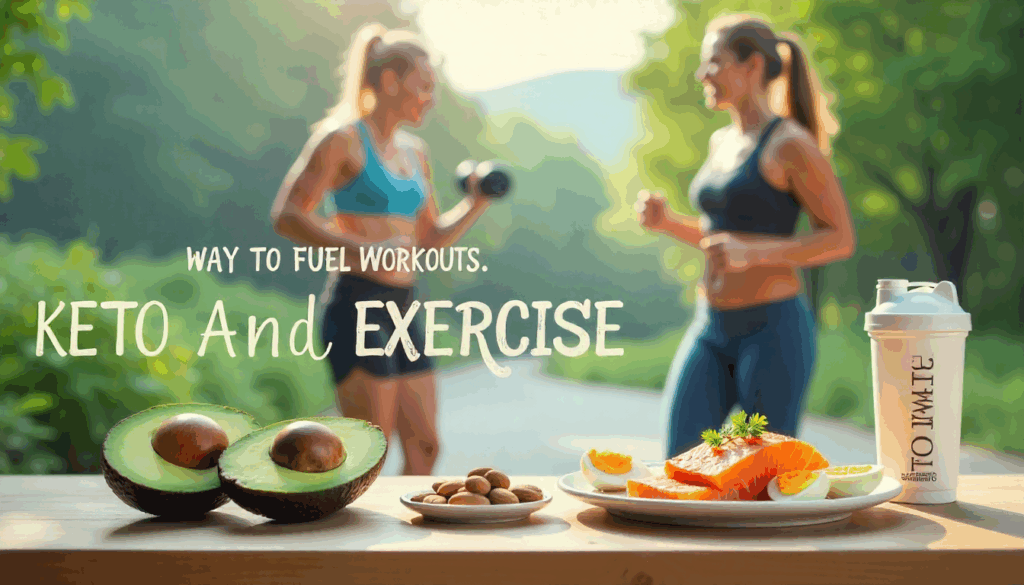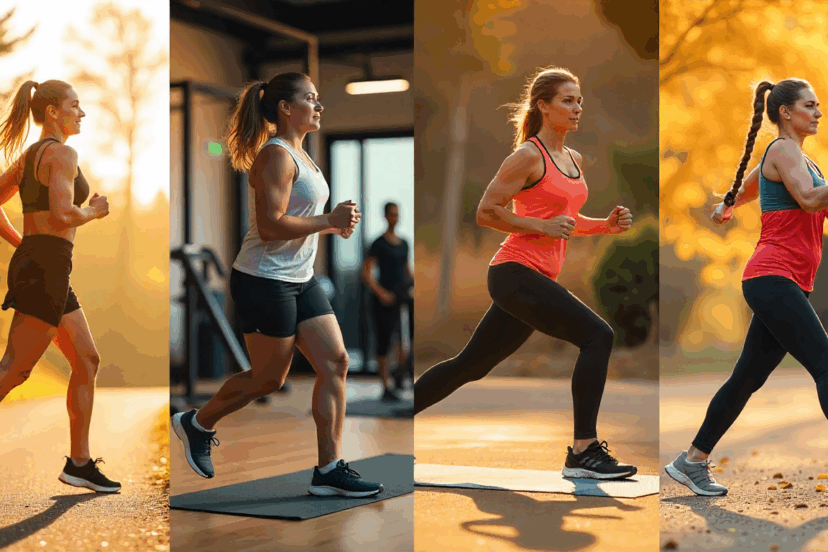Keto and Exercise: How to Fuel Your Workouts
The ketogenic diet, known for its low-carb, high-fat approach, has gained popularity for its numerous health benefits, including weight loss and improved mental clarity. However, many people wonder how to maintain energy and optimize performance during workouts while on a keto diet. In this article, we’ll explore how to fuel your workouts on keto, including the best pre- and post-workout snacks, supplements, and practical tips for maximizing your performance at any age.
Understanding the Keto Diet and Exercise
On a standard diet, your body primarily relies on glucose (carbohydrates) for energy. When you switch to a keto diet, your body enters ketosis, a state where it burns fat for fuel instead of glucose. This shift can significantly impact your energy levels and how your body performs during exercise.
If you want a simple way to get started, a structured plan like the Custom Keto Diet Plan can provide tailored meals that keep your macros balanced and your workouts fueled.
Transitioning to Keto: What to Expect
During the initial phase of transitioning to keto, you might experience the “keto flu”, characterized by fatigue, headaches, and irritability. This is your body’s natural response to switching from glucose to fat as its primary energy source. Be patient—this phase is temporary. Staying hydrated and replenishing electrolytes can significantly ease the adjustment.
Fueling Your Workouts on Keto
1. Prioritize Electrolytes:
Electrolyte balance is crucial on keto, especially during exercise. Sodium, potassium, and magnesium are essential for muscle function and energy. Incorporate foods like avocados, leafy greens, nuts, and seeds—or supplement with a high-quality electrolyte blend.
💡 Pro Tip: A quick homemade electrolyte drink with water, sea salt, and lemon is a budget-friendly option.
2. Stay Hydrated
Since keto has a mild diuretic effect, dehydration can set in quickly. Aim for 8–10 glasses of water daily, and increase intake on heavy training days. Adding a pinch of salt or an electrolyte powder to your water can boost hydration.
3. Keto-Friendly Pre-Workout Snacks
Fuel up with balanced fats and moderate protein:
- A handful of almonds or walnuts
- Avocado slices with sea salt
- Hard-boiled eggs
- Greek yogurt with a drizzle of MCT oil
🔥 Affiliate Idea: Try recipes from Keto Comfort Foods for creative snack inspiration that fuels your workouts while keeping carbs low.
4. Optimize Post-Workout Nutrition
Recovery is key. After exercise, focus on quality protein and healthy fats:
- Grilled chicken with avocado
- Protein shake with almond milk and MCT oil
- Smoked salmon with cream cheese
- Cottage cheese topped with a few berries
If you struggle with planning meals, the Custom Keto Diet Plan includes tailored post-workout recipe ideas that help with muscle repair and steady energy.
5. Consider Targeted Keto
Some athletes benefit from targeted keto, where a small dose of carbs (15–30g) is consumed before or after workouts. Think berries, a small sweet potato, or a keto-friendly sports drink. This strategy may improve performance in high-intensity sessions like HIIT.
6. Incorporate MCTs for Energy
Medium-chain triglycerides (MCTs) are fats that your body converts into ketones quickly—making them perfect for workout fuel. Stir MCT oil into coffee, add to shakes, or use in pre-workout snacks.
7. Listen to Your Body
Everyone’s response to keto and exercise is unique. Keep a food and workout journal to track your energy, recovery, and performance, adjusting your nutrition accordingly.
Types of Exercise on Keto
1. Endurance Training (Aerobic Exercise)
Examples: Running, cycling, swimming, hiking, rowing.
- On keto, endurance training is often easier because fat becomes a steady, reliable fuel source.
- Once fat-adapted, many athletes report fewer energy crashes compared to carb-heavy fueling.
- Tip: Prioritize electrolytes (sodium, potassium, magnesium) and healthy fats to sustain long-duration activities.
2. Strength Training (Anaerobic Exercise)
Examples: Weightlifting, resistance bands, bodyweight exercises.
- Strength workouts rely heavily on protein for muscle repair and growth.
- While carbs are limited, adequate protein and fat provide the energy and recovery support needed.
- Tip: Add a protein shake with MCT oil after lifting to boost muscle repair.
3. High-Intensity Interval Training (HIIT)
Examples: Sprints, CrossFit, bootcamp classes, Tabata.
- HIIT requires quick bursts of energy, which are usually powered by glucose. On strict keto, this may feel harder at first.
- Many athletes try Targeted Keto (TKD), where a small amount of carbs is eaten before workouts, to improve performance.
- Tip: Experiment with 15–30g of carbs (like berries or a keto-friendly sports drink) before HIIT if you struggle with intensity.
4. Flexibility & Recovery Workouts
Examples: Yoga, stretching, Pilates.
- These don’t demand rapid fuel but still benefit from keto’s stable energy and anti-inflammatory effects.
- Tip: Use these sessions for active recovery days to balance more intense workouts.
5. Low-Intensity Steady State (LISS)
Examples: Walking, light cycling, gentle cardio.
- Perfectly suited to keto because the body easily uses fat stores for energy at this pace.
Tip: A long walk or hike while fasted can be a great way to boost fat-burning.
Supplements to Consider
- Electrolytes (sodium, potassium, magnesium) to prevent cramping
- MCT oil for quick energy
- BCAAs to support recovery
- Creatine for strength and power during intense training

Additional Tips for Keto and Exercise
Manage Recovery Days
Active recovery—like walking, stretching, or yoga—works well on keto because fat provides stable energy without spikes or crashes.
Meal Prep for Success
Preparing meals ahead of time prevents poor food choices after workouts. A meal prep guide like Keto Comfort Foods can help you stay consistent and enjoy your food.
Pair Keto with Intermittent Fasting
Some athletes combine keto with fasting for enhanced fat-burning. Start slow and monitor how your body responds before attempting fasted workouts.
Conclusion
Fueling your workouts on keto requires a balance of proper hydration, electrolytes, smart snack choices, and listening to your body. With strategies like targeted keto, MCT supplementation, and quality meal planning, you can train effectively while staying in ketosis.
If you’re looking for structure, the Custom Keto Diet Plan and Keto Comfort Food Recipes can help you enjoy delicious meals that support both your fitness goals and your keto lifestyle.
Remember: keto and exercise can work beautifully together when fueled with intention. Stay consistent, give your body time to adapt, and enjoy the journey!
FAQs: Keto and Exercise
1. Can I build muscle on keto? Yes! With sufficient protein intake and resistance training, you can gain muscle on keto. Adding a post-workout protein shake helps maximize recovery.
2. Do I need carbs to perform well in the gym? Not necessarily. Many people thrive on fat and ketones as fuel. However, if you’re doing intense training, targeted keto with small carb intake may boost performance.
3. What’s the best pre-workout on keto? Simple options like nuts, avocado, or Greek yogurt with MCT oil provide clean energy without carbs.
4. Should I avoid cardio while starting keto? During adaptation, you may feel sluggish. Light cardio is fine, but save intense workouts for after your body adjusts.
5. How long until I feel strong during workouts on keto? Most people adapt within 2–6 weeks. Once fat-adapted, many report better endurance and more stable energy than before.




